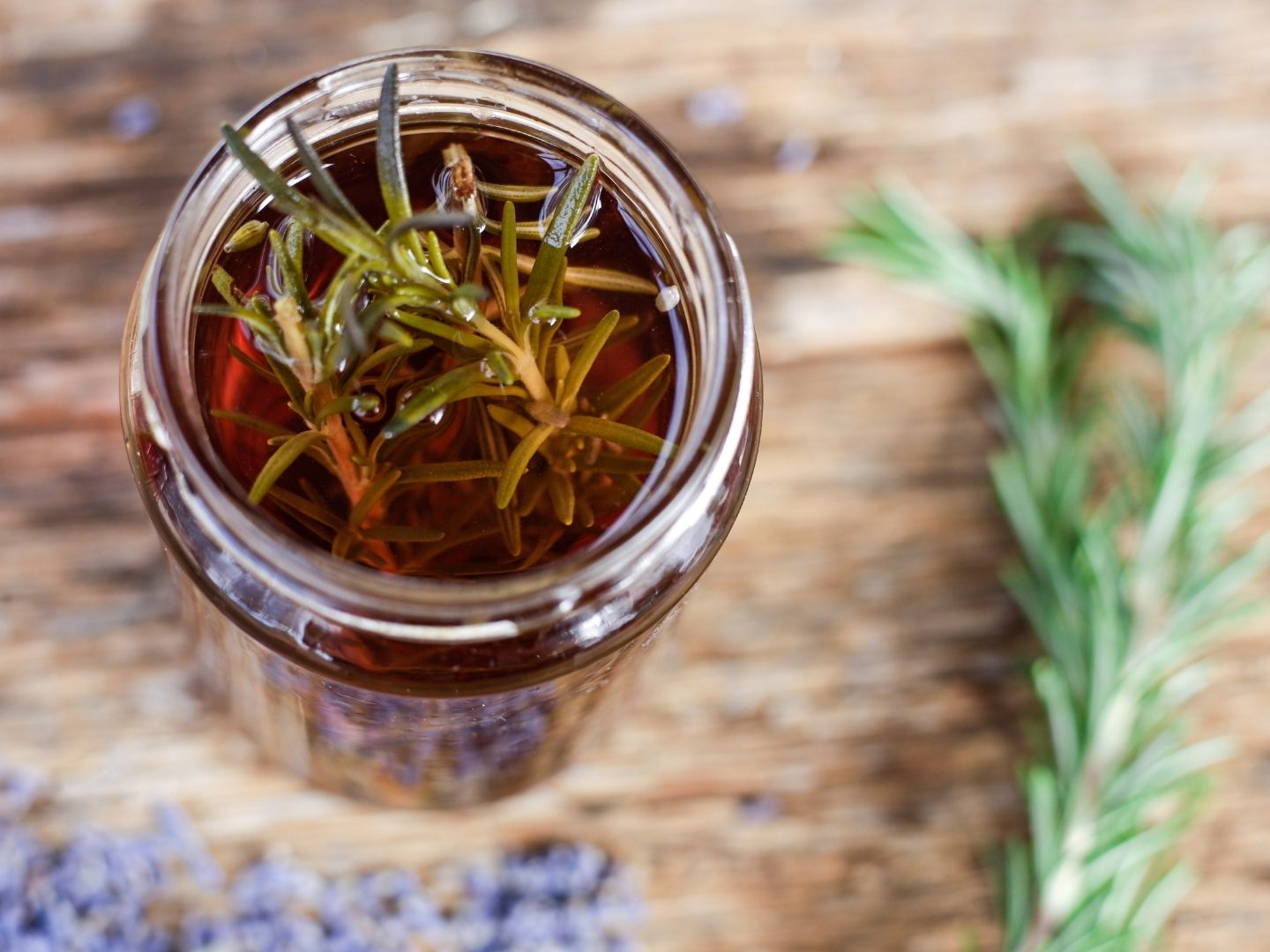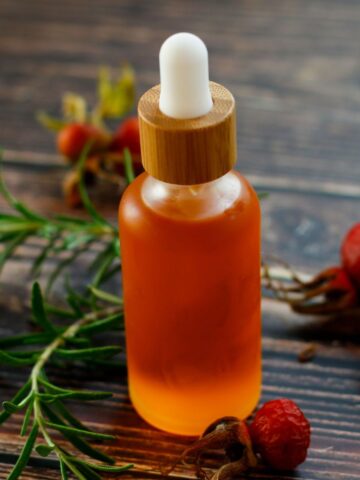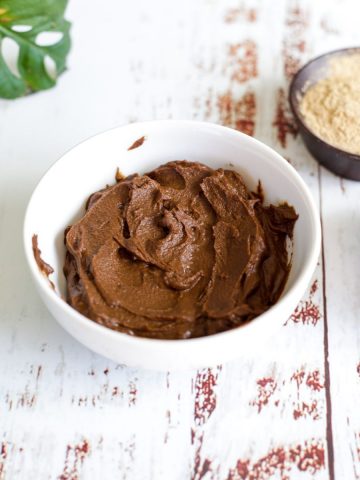Rosemary water for hair growth is now all the rage and is going viral on social media! But does it actually work? Is it really this magical remedy for hair loss, for shiny, smooth hair, for faster hair growth and for reducing the appearance of grey hair?

In this article, not only will I answer all these questions, but also give you a very simple and easy recipe to make your own rosemary water at home! Plus, those many ways how you can use it!
Contents
Rosemary for hair
- faster, healthy hair growth
- shiny, smooth hair
- reduce hair loss
- prevent premature greying
- prevent dandruff
- promote scalp health (dry, itchy scalp)
Rosemary has been used in traditional medicine for centuries as a natural remedy for many different diseases, treating ailments and pain. Besides its uses for respiratory problems, gastrointestinal stress, relieving stress and anxiety as well as an anti-inflammatory and pain relief, rosemary also has a great effect on our hair and scalp.
Rosemary is known to improve blood flow which helps stimulate the hair follicles and supply more blood to the roots preventing the hair from dying thus, from falling out.
By stimulating blood circulation, rosemary also helps prevent premature greying, boost hair growth and make your hair look shiny, smooth and healthy. In particular, if you have dry hair.
Because of its anti-inflammatory properties, rosemary may also help reduce the appearance of dandruff and relieve a dry, itchy scalp. Healthy scalp, healthy hair!
And, this rosemary water spray is suitable for all hair types.
Rosemary oil or rosemary water – what’s better?
To cut things short: both rosemary oil and water have shown increased hair growth/reduced hair loss in studies[1][2]. So, if this is your main goal, I think, it doesn’t really matter which one you use.
Rosemary essential oil is just more concentrated than rosemary water (aka rosemary leaf extract) which may make the oil a bit more powerful, and more effective. However, in this study (that was done on mice, though), rosemary extract has shown significant results for stimulated hair growth.
To be honest, I couldn’t find a decent report on how well rosemary water works concerning dandruff and dry, itchy scalps. But I reckon, it would do just as well as rosemary oil!
So, mainly, the difference between rosemary oil and water is how you’re gonna use it and, well, the price.
Rosemary essential oil isn’t very expensive, of course, and you’ll only need a drop or two (plus your carrier oil) for each treatment. But making your own rosemary water is not only easy but also cheaper—especially if you’ve got a rosemary plant growing in your garden!
Also, using oil on your hair might not be the right thing for you because rosemary essential oil may irritate the skin. Whereas rosemary water is a bit milder (though, it might irritate the skin too if you react to it, mind).
In conclusion, I’d say rosemary oil isn’t better than rosemary water (mind, this is my personal opinion, I’m not a scientist or herbalist to prove this). Especially, when it comes to hair growth. It just depends on your liking, really.
Ingredients
Affiliate Disclaimer: This article contains affiliate links. That means I may earn a small commission, if you purchase the linked product, at no extra cost for you.
Now, with all that being said, let’s dive into the making of your rosemary water for hair!
- Fresh rosemary twigs OR dried rosemary leaves
- water (filtered, if needed)
That’s it. That’s all you need. Simple, isn’t it? Later on, I’ll also give you some extras you can add depending on how you want to use this rosemary water.
If I were you, and you don’t have your own rosemary plant in your backyard, I’d make sure to use organic rosemary! You really don’t want any chemicals in your rosemary water! You'll get rosemary, fresh or dried, easily in your grocery store.
If your water isn’t very pure, you might want to use filtered/distilled water or purify the tap water first. It just reduces chemicals in your homemade rosemary water.
Instructions
There are two ways to make this rosemary water for hair. Here, again, I couldn’t find a report that would suggest which of the methods is the better one so I’d say, go with your guts. Go with what you think makes more sense to you.
Method 1 – brewing rosemary tea: using this method, you’re simmering the rosemary twigs in water for an extended time in order to extract the components.
Method 2 – making a rosemary infusion: using this method you steep the rosemary twigs for hours to gently extract the components.
Method 1 – rosemary tea
- Place 2 cups of water in a saucepan and bring water to a boil. Add fresh rosemary sprigs (or dried leaves).
- Reduce heat to a simmer.
- Let simmer for 40 minutes up to an hour (some people also like to do it for hours…I’m not quite sure if that’s necessary though).
- Strain rosemary tea immediately or let it cool down to room temperature to infuse even further. Pour the rosemary water into a spray bottle (preferably glass or metal, if the rosemary tea is still very hot) or a large enough mason jar.
Method 2 – rosemary infusion
- Start by boiling water in a jug/kettle and let it cool down to about 80°C/175°F (about 20 minutes or so).
- Place rosemary in a large enough mason jar, a bowl or a saucepan and add water.
- Steep rosemary for at least 5 or up to 12 hours (maybe even a few hours longer, or simply over night, if you like).
- Strain rosemary infusion. You can pour the infusion into a spray bottle or a jar.
I prefer this method because it’s a gentler method. I learned once that herbalists actually say that using high temperatures may destroy some of the herb's components. It’s, therefore, better to use lower temperatures (80°C/175°F and below).
I leave this up to you which method you prefer though. Simmering the herbs (method 1) may also mean more components get extracted but I don’t know if that’s really the case because, as I said, I’m not a scientist or herbalist.

How to use rosemary water for your hair
- hair mask
- hair rinse / conditioner
- leave-in treatment or conditioner
- in combination with an aloe vera hair mask (for hair growth) or rice water
Rosemary water hair mask
- Using a spray bottle, spray rosemary water all over your hair and scalp until your hair is all wet.
- Or simply pour rosemary water over your hair and scalp. Make sure to place a bowl underneath to catch the rosemary water again and reuse it. Do this until your hair is all wet.
- Massage your scalp in a circular motion. You can also gently pull on tufts of hair and twist them a bit. This improves blood circulation even further. Finally, massage all the way down your hair.
- Cover your hair with a shower or sleeping cap or wrap a towel around your head.
- Leave the rosemary water hair mask in for 30 minutes up to an hour. Or use this hair mask as an overnight treatment.
- Use this rosemary hair mask as often as you please (yes, daily is okay because you wash it out afterwards!).
Rosemary hair rinse / conditioner
- Wash your hair as usual
- Slowly pour little amounts of the rosemary water over your head, letting it run down your hair (or use a spray bottle, if you prefer).
- Massage your scalp in a circular motion. This improves the blood circulation even further. Finally, massage all the way down your hair.
- Leave it in for a few minutes, for example, while you shave, wash your body or do a peeling.
- Rinse it out.
- Use this rosemary hair rinse or conditioner as often as you please (yes, daily is okay because you wash it out afterwards!).
Leave-in treatment or conditioner
- After you’ve washed your hair, use a spray bottle and spray the rosemary water all over your hair, especially onto the scalp.
- Massage your scalp in a circular motion. This improves the blood circulation even further. Finally, massage all the way down your hair.
- Style your hair as usual.
- Use this rosemary leave-in treatment or conditioner about once or twice a week. You can still use the hair mask or rinse every day because you wash the rosemary water out afterwards.
In combination with an aloe vera hair mask
This is probably my favourite way to use this rosemary water for my hair. I’ve been using my aloe vera hair mask for several months now and I just love the (almost) immediate effects of aloe vera (less hair loss!).
- After I’ve applied my aloe vera hair mask, I spray rosemary water all over my hair and scalp. This prevents the aloe vera gel from drying up too fast, I find.
- I then leave it in for 30 minutes before washing my hair.
The best way to get results from your rosemary water for hair
Consistency. Is. Key! You need to use rosemary water regularly to see some results. You don’t need to use it every day. 1-3 times per week should do the trick too.
As with all-natural remedies, give it time! Especially, for faster hair growth and hair loss. You may not see any results after months of using it. According to a study, they started to see some significant changes around the 6-month mark.
However, you may notice that your hair’s smoother and shinier after the first treatments already.
Scalp massages done regularly may also be beneficial as they stimulate blood flow, hence increasing the rate of hair growth.
Variations
- Apple Cider Vinegar
- Lavender
- Other herbs
Apple Cider Vinegar: you can add 2 tablespoons of apple cider vinegar to this rosemary water once it’s made and use it as a conditioner. Apple Cider Vinegar detangles your hair, balances the pH level of your hair and scalp, moisturises and reduces frizz.
Lavender: my favourite add-on (as you can see in the pictures). I add about 2 tablespoons of dried organic lavender buds at the same time I add the rosemary to the hot water. Lavender also helps with hair growth, is anti-inflammatory and soothes the skin.
Other herbs: you can also add other herbs for improving hair growth like peppermint, ginkgo and stinging nettle (again: organic. You can use fresh peppermint and nettle here as well).
Chamomile: Chamomile is a great herb to add, too, because of its soothing properties. It also prevents dry and brittle ends and if you’ve got blond or light brown hair, it brightens your colour and adds that golden glow!
Storage
Keep the rosemary water in the fridge for up to 7 days (or until it smells off).
You can also freeze it in batches and thaw it whenever you need it.
I usually make a big batch (double the recipe) and store the rosemary water in various small jars that I can keep in the pantry because of the way I seal them (it's very easy!).
So, this is how you do this: if you use method 1 (making rosemary tea) after you’ve strained it, pour the hot! rosemary tea into several small jars and tighten the lid to seal. When it cools down, the lid will get sucked on, sealing the jar airtight!
If you use method 2, after straining, you could either heat up the rosemary infusion again (making sure not to boil it. Once the steam is coming up, it’ll be hot enough). Or simply, let the rosemary steep in the jars. So, instead of using one big jar, you just use several small jars with one twig, cut in half, in each. You can leave the rosemary in the jars until you need the water.
Warnings & Safety
Generally, rosemary (the leaves, not the essential oil) is safe to use. Although rosemary may help an itchy, dry scalp, it might cause skin irritation if you react to it (as in an allergic reaction). If this occurs, stop using this rosemary water.
I always recommend doing a patch test first, before trying any of my recipes. This will eliminate any major discomfort due to allergic reactions.
📖 Recipe
Ingredients
- 5 twigs fresh rosemary prefarably organic
- OR 2-3 tablespoon dried rosemary prefarably organic
- 500ml/ 16oz. water distilled or filtered, if needed
Instructions
Method 1 – rosemary tea
- Place water in a saucepan and bring water to a boil. Add rosemary (fresh or dried).
- Reduce heat to a simmer. Let simmer for 40 minutes up to an hour.
- Strain rosemary tea immediately or let it cool down to infuse even further. Pour the rosemary water into a spray bottle (preferably glass or metal, if the rosemary tea is still very hot) or a large enough jar.
Method 2 – rosemary infusion
- Boil water in a jug/kettle and let it cool down to about 80°C/175°F (about 20 minutes or so).
- Place rosemary in a large enough mason jar, a bowl or a saucepan and add water.
- Steep rosemary for at least 5 or up to 12 hours (maybe even a few hours longer, or simply overnight, if you like).
- Strain rosemary infusion. You can pour the infusion into a spray bottle or a jar.
Storage
- Keep the rosemary water in the fridge for up to 7 days (or until it smells off).You can also freeze it in batches and thaw it whenever you need it.





Tina says
I make this regularly, and use it between shampoos, after I have been to the gym. I can maintain my once a week hair wash, with some Rosemary spritz!
Thank you so much for sharing this.
Looking into your homemade bath salts right after this!
Lavender Gypsy says
Thank you so much, Tina!! That's great :)!! Hope you enjoy the bath salts as well!